 My great grandfather Buck was born in Indian Territory before it was known as Oklahoma. As an old man he told his grandson the stories passed on to him by his own grandfather about a tribe of red headed giants who would come snatch away naughty children and gobble them up. The story was that long ago all the regional tribes banded together for the last remembered time on a singular mission. Choctaws, Alogonquins, Cherokee, Sioux and others supposedly all worked together to wipe out the giant cannibals; eliminating every man, woman & child. But oral tradition can be embellished with re-telling, and what evidence is there of any tall groups of ginger haired people in the South?
My great grandfather Buck was born in Indian Territory before it was known as Oklahoma. As an old man he told his grandson the stories passed on to him by his own grandfather about a tribe of red headed giants who would come snatch away naughty children and gobble them up. The story was that long ago all the regional tribes banded together for the last remembered time on a singular mission. Choctaws, Alogonquins, Cherokee, Sioux and others supposedly all worked together to wipe out the giant cannibals; eliminating every man, woman & child. But oral tradition can be embellished with re-telling, and what evidence is there of any tall groups of ginger haired people in the South? 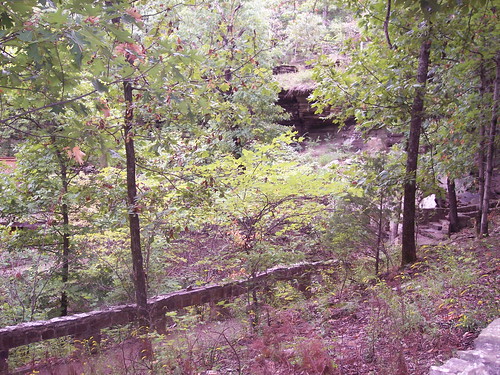
Well actually there are quite a bit of clues. If you ever decide to visit Eastern Oklahoma, spend some time at Heavener Runestone State Park. Around 600 a.d. there may have been a Viking named Glome (nicknamed Gloi) marking his territory on Poteau Mountain in Oklahoma near Heavener. Still vertical it stands at 12 foot tall, 10 feet wide and 16 inches thick, roughly the size of a billboard featuring only 8 letters. The Heavener Runestone translates to say "Glome's Valley" Amazingly, there are seven other known runestone monuments some positioned miles apart in a straight line across the the region. The grey land claim marker is made of Savannah Sandstone withstanding time and bearing an inscription carved in an alphabet used by Northern Europeans long before Columbus crossed the sea.
 Runes are a old Germanic & Scandanavian alphabet used from the 3rd to the 13th century. Just like English has gone from the Beowulf Old English spoken by the Anglo-Saxons to the modern newspeak L337 chatted by American teenagers, the runic alphabet being used changed over the centuries as well. The runic alphabet that most modern people recognize does not have the exact same letters as the Old Norse version and this caused a lot of argument in the earlier part of the last century over the authenticity of the norse inscriptions in Oklahoma.
Runes are a old Germanic & Scandanavian alphabet used from the 3rd to the 13th century. Just like English has gone from the Beowulf Old English spoken by the Anglo-Saxons to the modern newspeak L337 chatted by American teenagers, the runic alphabet being used changed over the centuries as well. The runic alphabet that most modern people recognize does not have the exact same letters as the Old Norse version and this caused a lot of argument in the earlier part of the last century over the authenticity of the norse inscriptions in Oklahoma. 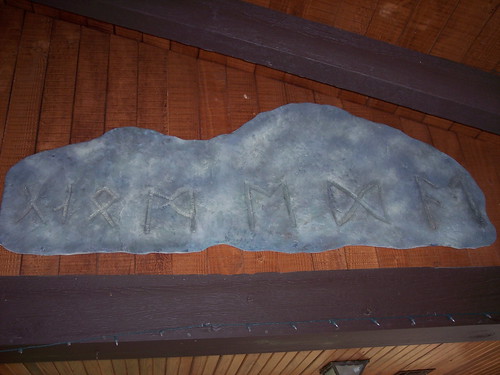
The Heavener Runestone is thought to have been inscribed as early as 600 a.d., and the alphabet used was determined to be from the oldest Germanic (Old Norse) Futhark by Dr. Richard Nielsen in 1986. This Old Norse Futhark was used from about 300 A.D. whereas by 800 A.D the Scandanavian Futhark had become the predominant alphabet for runes. Dr. Nielsen got his doctorate at the University of Denmark and they know an awful lot there about about runes, norsemen and lets just call them vikings.
 The nearby Poteau Runestone was found by two 13 year old boys on a hill in 1967 and translates to "Magic or Protection to Gloi". The Shawnee Runestone was found face down in a stream about two years later, it appears to be a grave marker for someone named 'Medok." Both markers are written in Old Norse Futhark. Two other smaller stones with fewer letters as well as a binding rune were also found strategically placed in the area, including one near Robbers Cave.
The nearby Poteau Runestone was found by two 13 year old boys on a hill in 1967 and translates to "Magic or Protection to Gloi". The Shawnee Runestone was found face down in a stream about two years later, it appears to be a grave marker for someone named 'Medok." Both markers are written in Old Norse Futhark. Two other smaller stones with fewer letters as well as a binding rune were also found strategically placed in the area, including one near Robbers Cave. 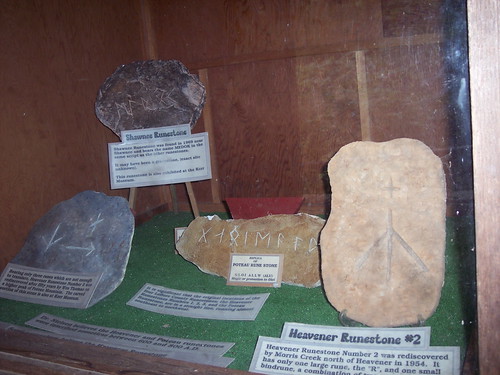
According to oral tradition, the Heavener Runestone was first discovered by a Choctaw hunting party in the 1830's not too long after the tribe had been removed from its ancient home of Mississippi and relocated to Oklahoma. Wilson King was hunting bear with two friends when they found the runestone somtime before reporting it in 1874 and they are the first modern white men on record to have seen the monument. By the time Carl Kemmerer reported finding the stone in 1913 others in the area already knew it as "Indian Rock." But the runes had been there before the Choctaws, before the French trappers named Poteau Mountain, before Desoto's men laid eyes on the mossy grey carved stone. The runic inscription had been there since the norse educated & or viking's descendent put it there.
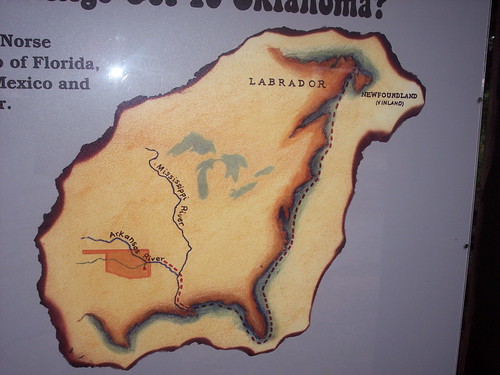
How much time did it take a Viking to get there himself? Months? Generations? This band of Norsemen had to travel from the known settlements in Greenland around the New England coast around Florida through the Gulf of Mexica and into Oklahoma by taking the Mississippi North to the Arkansas River in their flatbottomed long boats which easily navigated the rivers of the South.
Back in 1923, Kemmerer started the process of authentication by sending copies of the strange symbols to the Smithsonian Institute. In 1928, he showed the runes to a 12 year old little girl named Gloria Farley who was to devote the rest of her life to the research, translation and preservation of the monument over the next seventy years. It wasn't till 1965 that Oklahoma considered it as a site for state park. Over the next five years, support built for the project in Heavener (pronounced like heave-ho, not like with angels) and land was donated by the Leland Dial family. Senator Clem Hamilton appropriated funds for the park and a winding road was soon built up the mountainside to the park site.
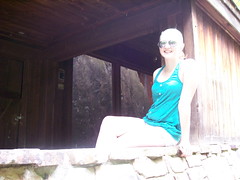 At the top of Runestone Road on the other side of the railroad tracks in Heavener is the day use state park. A stone path leads down stairs to the place where the marker has been naturally protected from erosion by rock overhangs and pokeberry bushes. Mrs. Farley's state park effort originally built a cage around the runestone to prevent vandalism in 1970 along with an interpretive center. Now the cage is gone and Heavener Runestone still remains settled in the same spot as it has for centuries, although enclosed behind plexiglass in a lovely cedar building. Encased to its right are reproductions of the other stones found in the area along with translations, history and a few security cameras to keep everything safe and undisturbed.
At the top of Runestone Road on the other side of the railroad tracks in Heavener is the day use state park. A stone path leads down stairs to the place where the marker has been naturally protected from erosion by rock overhangs and pokeberry bushes. Mrs. Farley's state park effort originally built a cage around the runestone to prevent vandalism in 1970 along with an interpretive center. Now the cage is gone and Heavener Runestone still remains settled in the same spot as it has for centuries, although enclosed behind plexiglass in a lovely cedar building. Encased to its right are reproductions of the other stones found in the area along with translations, history and a few security cameras to keep everything safe and undisturbed. One of the park's best feature is its spectacular view of the Poteau Valley... Glome's Valley I should say. Park is open from 8 a.m. till sunset and offers picnic tables, grills, gazebo and open air ampitheatre along with adequate bathroom facilities. Bring a picnic basket and your viking helmet.
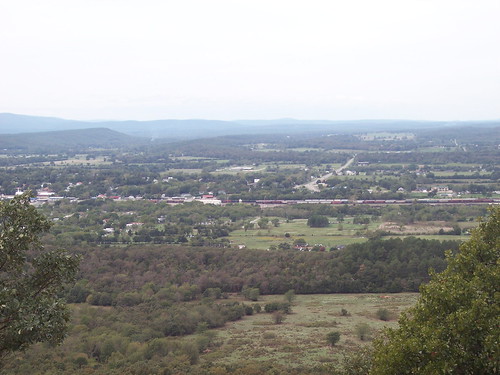
On your way out, stop in Heavener at the Southern Belle restaurant for some pie. Southern Belle is on Hwy 59 and housed within an old railroad dining car. They feature at least 10 different daily varieties of pie with a view of the KC Southern train switchyard that is framed by the mountain where you will find evidence of tall, red headed white men that found their way to Oklahoma.
BIBLIOGRAPHY
gallery of photographs taken on my trip to the site
Oklahoma State Park site for Heavener Runestone Park includes amenities list, pics of the park and a video of the late Gloria Farley. Park is about 4 hours north of Dallas in Heavener Oklahoma, about 2.5 miles north on Hwy 59 at the Hwy 270 junction, follow the signs to Runestone Road and enjoy the drive up the mountain.
most of the facts in this blog came from:"The Heavener Runestone" pamphlet by Gloria Farley published by Oklahoma Tourism and Recreation Dept., Div. of State Parks, 500 Will Rogers Bldg., OKC, OK 73105. Link to full text >click here<
"In Plain Sight: Old World Records in Ancient America". by Gloria Fa
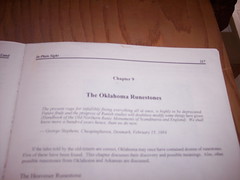 rley is a hardback documenting her lifelong research. It is 491 pages long with 540 illustrations, photographs and scale drawings and includes 338 pieces of evidence of visitations of her extensive Petroglyph research all over North America. Although strictly a non-fiction work with complete references, the book also contains stories of adventure and humor. It is currently used as a textbook in Heavener High School and Bentley College, Massachusetts. The book may be ordered from I.S.A.C. Press, P.O. Box 1658, Columbus, GA, 31902, The price per copy is $42.50 postpaid.
rley is a hardback documenting her lifelong research. It is 491 pages long with 540 illustrations, photographs and scale drawings and includes 338 pieces of evidence of visitations of her extensive Petroglyph research all over North America. Although strictly a non-fiction work with complete references, the book also contains stories of adventure and humor. It is currently used as a textbook in Heavener High School and Bentley College, Massachusetts. The book may be ordered from I.S.A.C. Press, P.O. Box 1658, Columbus, GA, 31902, The price per copy is $42.50 postpaid. for more about the translation from ancient Old Norse Futhark, read "The Runestones of Oklahoma" by Dr. Richard Nielsen. Epigraphic Society Occasional Publications, Vol. 16, 1987. ordered from 6625 Bamburgh Dr., San Diego CA 92217
Heavener ISD profile of Gloria Farley
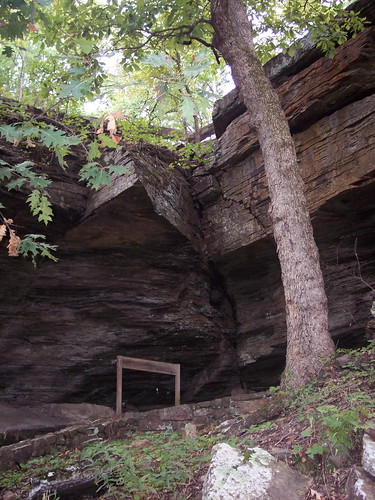

No comments:
Post a Comment